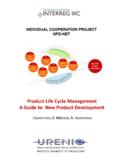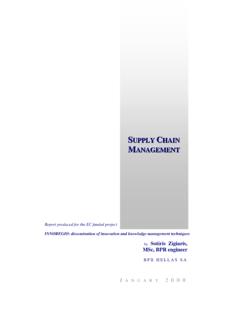Transcription of A Guide to New Product Development Product Life Cycle ...
1 1. Product Life Cycle Management A Guide to New Product Development , D. Milossis, N. Komninos 2. This Guide has been produced in the framework of INTERREG IIIC operation NPD-NET. ( ). NPD-NET is a network of six European institutions aiming to enhance the capability of European companies in the New Product Development (NPD). The project is based on the Development and implementation of a web-based Guide to provide support material for the whole NPD process from the idea generation through the Product commercialization. NPD-NET is funded by INTERREG. IIIC. The material of the New Product Development Guide has been collected from various sources, referred in the Guide content. URENIO was only responsible for the organization and editing of the material included. The original owners of the material are clearly referred in all chapters of this New Product Development Guide . This Guide is also presented and organized in web form in the web site of the project NPD-NET ( ).
2 Scientific coordination of NPD-NET and the NPD Guide has been provided by Prof Nicos Komninos. The Development and organization of the material of the Guide has been done by Ioannis Komninos. The editing of the Guide has been done by Dimitris Milossis. 3. TABLE OF CONTENTS. TABLE OF CONTENTS .. 3. INTRODUCTION .. 8. NPD STAGE 1: IDEA GENERATION .. 10. TOOLS & SOLUTIONS .. 10. Brainstorming .. 11. Brainstorming Methods .. 12. Affinity diagrams .. 12. Osborne's 13. Multivoting .. 13. Case Studies - Examples .. 14. Brainstorming Tool from Urenio .. 15. Consultants - Experts .. 15. Software Tools .. 15. References .. 16. Competitive Intelligence .. 16. Improving CI Capabilities .. 17. Case Studies - Examples .. 18. Consultants - Experts .. 19. Online Resources .. 20. On-line CI Sources .. 20. Tools from Urenio Research Unit .. 20. References .. 20. Conjoint Analysis .. 21. Case Studies - Examples .. 22. Consultants - Experts .. 24. Software Tools.
3 24. References .. 25. Delphi Technique .. 25. Consultants - Experts .. 26. References .. 26. Morphological Charts .. 27. Case Studies Examples .. 27. References .. 29. Six Thinking Hats .. 29. Case Studies - Examples .. 30. 31. TRIZ - Idea generation using a problem-solving tool .. 31. TRIZ Process Methodology .. 33. Consultants - Experts .. 34. References .. 34. LEVEL ASSESSMENT FOR STAGE 1: IDEA GENERATION .. 34. NPD STAGE 2: IDEA SCREENING .. 35. TOOLS & SOLUTIONS .. 35. Qualitative Research .. 36. Case Studies - Examples .. 37. Consultants - Experts .. 37. Software Tools .. 38. References .. 38. FMEA (Failure Modes and Effects Analysis) .. 38. References .. 39. Dot Sticking .. 39. 4. Case Studies - Examples .. 40. SWOT Analysis .. 41. Case Studies - Examples .. 42. References .. 43. PMI Analysis .. 44. Case Studies - Examples .. 44. LEVEL ASSESSMENT FOR STAGE 2: IDEA SCREENING .. 45. NPD STAGE 3: CONCEPT Development & TESTING.
4 46. CONCEPT Development .. 46. Controlled Convergence .. 46. References .. 47. Risk Management .. 48. Risk Management Process .. 48. Case Studies - Examples .. 49. References .. 50. Force Field Analysis .. 50. References .. 51. Relevancy Concepting .. 52. New Tech Commercialization .. 53. Quicktime Workshop .. 53. CONCEPT TESTING .. 55. Quantitative 55. References .. 56. Quality Functional Deployment .. 57. Case Studies - Examples .. 58. QFD Tool from Urenio .. 59. Consultants - Experts .. 59. Software Tools .. 59. References .. 60. Decision Tree Analysis .. 60. KANO Model .. 64. KANO Model Methodology .. 66. Case Studies - Examples .. 67. References .. 68. Weighting and Rating .. 68. Case Studies - Examples .. 69. Communications Check .. 70. Concept Screen Software .. 71. LEVEL ASSESSMENT FOR STAGE 3: CONCEPT 71. NPD STAGE 4: BUSINESS ANALYSIS .. 72. TOOLS & SOLUTIONS .. 72. Cost Benefit Analysis .. 72. Cost Benefit Analysis Tool: "Financing Innovation".
5 73. Product Life Cycle .. 73. PLC Quick Reference .. 74. References .. 75. Gantt Charts .. 76. Case Studies - Examples .. 77. References .. 79. Critical Path Analysis & 79. Stakeholder Analysis .. 80. Stakeholder Analysis Management .. 82. Stakeholder Analysis Planning .. 82. References .. 83. LEVEL ASSESSMENT FOR STAGE 4: BUSINESS ANALYSIS .. 84. NPD STAGE 5: BETA & MARKET TESTING .. 85. 5. TOOLS & SOLUTIONS .. 85. Rapid Prototyping .. 86. Prototyping Testing .. 87. Prototyping Techniques .. 89. Fused Deposition Modelling (FDM) .. 89. 90. Laminated Object Manufacturing .. 91. Laser Engineered Net Shaping .. 92. Selective Laser Sintering .. 93. Stereolithography .. 94. Three Dimensional Printing .. 95. Case Studies - Examples .. 95. Software Tools .. 97. References .. 97. Product Development Testing .. 98. Exploratory Tests .. 99. Assessment Tests .. 100. Validation 100. Comparison Tests .. 101. ISO 9000 Tests .. 101. Market Research Issues.
6 101. Market Targeting Strategy .. 101. Market segmentation .. 102. LEVEL ASSESSMENT .. 103. NPD STAGE 6: TECHNICAL IMPLEMENTATION .. 104. TOOLS & SOLUTIONS .. 104. Design for 104. Design for Manufacture .. 105. Design of Assembly .. 106. Design for Life Cycle .. 106. Design for Testability / 107. Design for Reliability .. 108. Design for Maintainability / Serviceability .. 108. Design for the Environment .. 109. References .. 110. Industrial Design .. 111. Industrial Design Management .. 111. Industrial Design Activity Map .. 113. Sketch & 114. Sketch 114. 2D Technical Drawing .. 115. 3D Digital Model (Constrained) .. 116. 3D Digital Model (Unconstrained) .. 118. Appearance Model .. 119. Computer Visualisation .. 120. Presentation - Illustration .. 120. 121. Consultants - Experts .. 122. References .. 123. Lean Manufacturing .. 123. Electrical Engineering 123. Mechanical Engineering Level .. 124. System Engineering Level .. 124. Just In Time (JIT).
7 124. CAD/CAM .. 125. References .. 126. Re-engineering .. 126. Case Studies - Examples .. 127. Software Tools .. 127. Consultants - Experts .. 127. 6. References .. 127. Reverse Engineering .. 128. Reverse Engineering Methodology .. 128. Major Applications .. 130. Reverse Engineering of Business .. 130. Reverse Engineering of Electronic Components .. 130. Reverse Engineering of Software .. 130. Case Studies - Examples .. 131. Consultants - Experts .. 131. References .. 131. Major Manufacturing Issues .. 132. Bill of Material (BOM) .. 132. Mass production .. 135. Producibility .. 135. Quality Assurance .. 136. Value Engineering .. 138. LEVEL ASSESSMENT .. 139. NPD STAGE 7: Product COMMERCIALISATION .. 140. TOOLS & SOLUTIONS .. 140. Marketing Plan .. 140. The Elevator Speech .. 141. Product on a Page - Advert .. 141. Distribution Channels .. 142. Distribution Definition and Considerations .. 142. Distribution Channel Strategy .. 143. Types of Distribution Channels.
8 144. Product Pricing .. 145. Product Pricing Objectives .. 145. Pricing Methods .. 146. Competitor Indexing .. 146. Cost-plus 147. Price Skimming .. 147. Target Rate of Return Pricing .. 148. Product Promotion .. 148. Advertising .. 149. Advertising Channels .. 149. Ways to get Free Advertising .. 151. Product Placement .. 152. Personal Selling .. 152. Publicity & Public relations .. 153. Sales Promotion .. 154. Consumer Promotion Techniques .. 155. Trade Promotion Techniques .. 155. LEVEL ASSESSMENT .. 156. 8. GENERAL PURPOSE TOOLS .. 157. BENCHMARKING TOOL, URENIO RESEARCH 157. BUSINESS PROCESS REENGINEERING .. 157. Business Process Reengineering Methodology .. 157. References .. 158. COLLABORATIVE Product 158. HUMAN RESOURCES MANAGEMENT .. 159. MARKET RESEARCH TOOLS .. 162. Product OUTSOURCING .. 162. What to do and what don't for successful outsourcing .. 164. References .. 164. PORTFOLIO MANAGEMENT .. 165. References .. 166. SUPPLY CHAIN MANAGEMENT.
9 167. 7. THE PLANNING Cycle .. 167. APPENDICES .. 169. APPENDIX 1: LEVEL ASSESSMENT FOR NPD STAGE 1: IDEA GENERATION .. 170. APPENDIX 2: LEVEL ASSESSMENT FOR NPD STAGE 2: IDEA SCREENING .. 172. APPENDIX 3: LEVEL ASSESSMENT FOR NPD STAGE 3: CONCEPT Development .. 173. APPENDIX 4: LEVEL ASSESSMENT FOR NPD STAGE 4: BUSINESS ANALYSIS .. 175. APPENDIX 5: LEVEL ASSESSMENT FOR NPD STAGE 5: Product TESTING .. 177. APPENDIX 6: LEVEL ASSESSMENT FOR NPD STAGE 6: TECHNICAL IMPLEMENTATION .. 179. APPENDIX 7: LEVEL ASSESSMENT FOR NPD STAGE 7: COMMERCIALISATION .. 182. APPENDIX 8: QUESTIONNAIRES FOR MARKET 184. Introduction . 8. INTRODUCTION. The existence and the course of a business in the form of a company, enterprise or corporation is directly linked with the course of its products. A business unit exists to sell products and as far as the Product sales go well so is the business unit. Products like everything else in life have a certain life Cycle .
10 Each Product goes through this life Cycle and eventually dies out. Products, which were once a household name, have disappeared from the market as they entered the decline phase of their life Cycle . So due to this fact the long-term operation of a business depends on the on going Development of new products. The rapid Development of new technologies, the shift change in customer needs and attributes, and the gradual increase of the competition has forced all business to adopt New Product Development (NPD) as a necessary and unavoidable business practice. NPD is a complex and time-consuming process, which cannot be taken lightly, since it holds more perils than first meets the eye. According to David S. Hopkins and Earl L. Baily1 research has shown that 40% of new consumer products, 20% of new industrial products and 18% of new services related products have failed completely as products. Further research has shown that the new Product failure percentage is even greater in countries outside the US.



